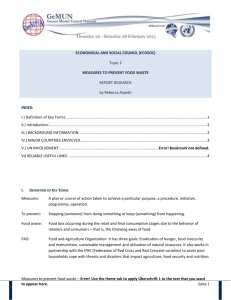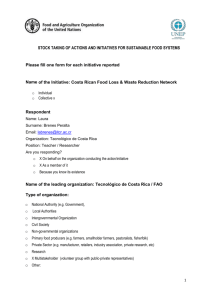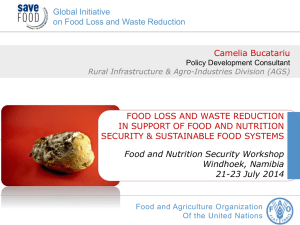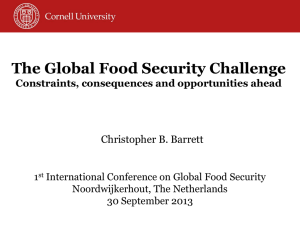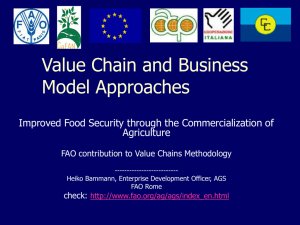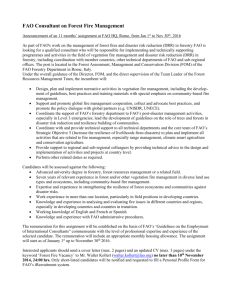Save Food - Comments on HLPE V0 6Feb2014
advertisement
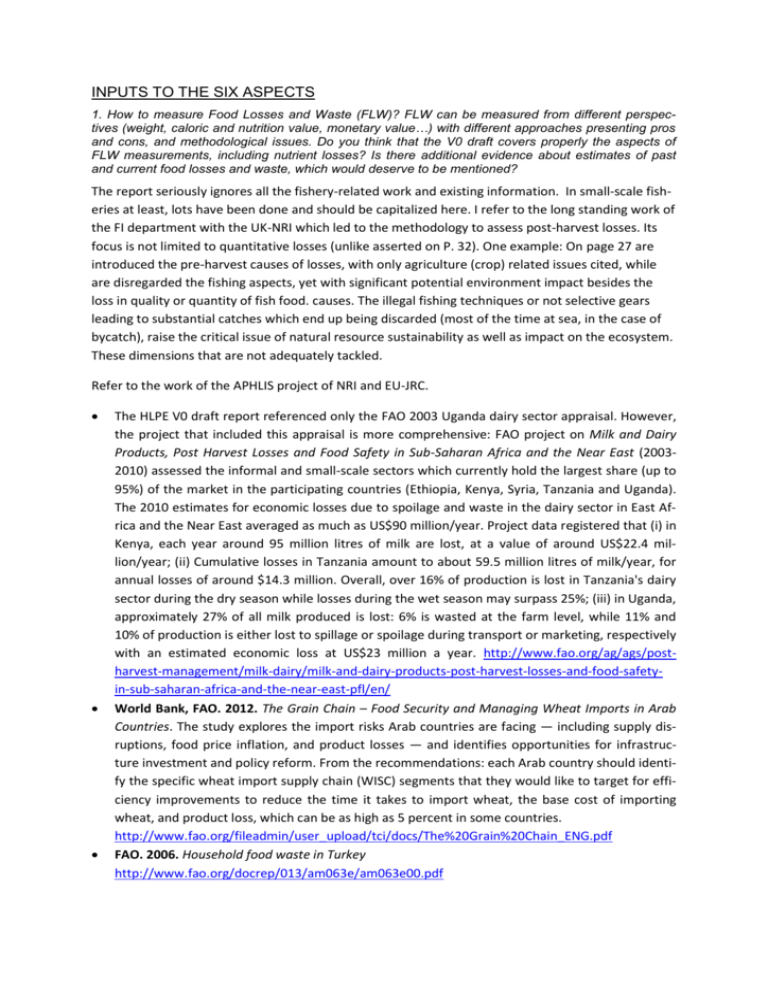
INPUTS TO THE SIX ASPECTS 1. How to measure Food Losses and Waste (FLW)? FLW can be measured from different perspectives (weight, caloric and nutrition value, monetary value…) with different approaches presenting pros and cons, and methodological issues. Do you think that the V0 draft covers properly the aspects of FLW measurements, including nutrient losses? Is there additional evidence about estimates of past and current food losses and waste, which would deserve to be mentioned? The report seriously ignores all the fishery-related work and existing information. In small-scale fisheries at least, lots have been done and should be capitalized here. I refer to the long standing work of the FI department with the UK-NRI which led to the methodology to assess post-harvest losses. Its focus is not limited to quantitative losses (unlike asserted on P. 32). One example: On page 27 are introduced the pre-harvest causes of losses, with only agriculture (crop) related issues cited, while are disregarded the fishing aspects, yet with significant potential environment impact besides the loss in quality or quantity of fish food. causes. The illegal fishing techniques or not selective gears leading to substantial catches which end up being discarded (most of the time at sea, in the case of bycatch), raise the critical issue of natural resource sustainability as well as impact on the ecosystem. These dimensions that are not adequately tackled. Refer to the work of the APHLIS project of NRI and EU-JRC. The HLPE V0 draft report referenced only the FAO 2003 Uganda dairy sector appraisal. However, the project that included this appraisal is more comprehensive: FAO project on Milk and Dairy Products, Post Harvest Losses and Food Safety in Sub-Saharan Africa and the Near East (20032010) assessed the informal and small-scale sectors which currently hold the largest share (up to 95%) of the market in the participating countries (Ethiopia, Kenya, Syria, Tanzania and Uganda). The 2010 estimates for economic losses due to spoilage and waste in the dairy sector in East Africa and the Near East averaged as much as US$90 million/year. Project data registered that (i) in Kenya, each year around 95 million litres of milk are lost, at a value of around US$22.4 million/year; (ii) Cumulative losses in Tanzania amount to about 59.5 million litres of milk/year, for annual losses of around $14.3 million. Overall, over 16% of production is lost in Tanzania's dairy sector during the dry season while losses during the wet season may surpass 25%; (iii) in Uganda, approximately 27% of all milk produced is lost: 6% is wasted at the farm level, while 11% and 10% of production is either lost to spillage or spoilage during transport or marketing, respectively with an estimated economic loss at US$23 million a year. http://www.fao.org/ag/ags/postharvest-management/milk-dairy/milk-and-dairy-products-post-harvest-losses-and-food-safetyin-sub-saharan-africa-and-the-near-east-pfl/en/ World Bank, FAO. 2012. The Grain Chain – Food Security and Managing Wheat Imports in Arab Countries. The study explores the import risks Arab countries are facing — including supply disruptions, food price inflation, and product losses — and identifies opportunities for infrastructure investment and policy reform. From the recommendations: each Arab country should identify the specific wheat import supply chain (WISC) segments that they would like to target for efficiency improvements to reduce the time it takes to import wheat, the base cost of importing wheat, and product loss, which can be as high as 5 percent in some countries. http://www.fao.org/fileadmin/user_upload/tci/docs/The%20Grain%20Chain_ENG.pdf FAO. 2006. Household food waste in Turkey http://www.fao.org/docrep/013/am063e/am063e00.pdf 2. What are the key policy aspects to reduce food losses and waste in order to improve the sustainability of food systems, in different countries and contexts? Is there evidence about the potential of economic incentives, and which ones (taxes, etc.)? What margins for policies in the context of food safety laws and regulations, such as expiration dates? If this report is to draw high attention of policy makers it deserves to be designed to care for this purpose, at least in the headings and rearranging the ideas so as to make visible the responsibility of different stakeholders in the FSC. Somewhere it was reasonably advised that measures to reduce losses and waste rest upon micro-level and macro-level solutions, but then throughout the following more than 10 pages covering this topic, this approach was not clearly evidenced. In the relevant chapters addressing the environmental impacts, the waste of wood wherever it is used in the food supply chains should be dully considered (example: as fuelwood in processing). Page 64, lines 43-45: “The role played by women in the prevention of food losses and waste need immediate attention. Women play a key role in reducing food losses in developing countries and the challenges faced by poor women in food loss reduction should be analyzed and documented.” I would put it in a different way: In most food systems women play a key-role in food security, and especially in smallholder-based rural communities food loss reduction benefits women directly, enabling them to improve food security for their families and the community. The policy/regulatory environment is multi-stakeholder (public and private sector, civil society), dynamic, and responsive to changes in the political and economic contexts. It also influences the public-private funding priorities, prioritization of emerging needs (e.g. increased food prices, limited natural resources, technological and social innovation, urbanization) and of innovation opportunities. o The policy evaluation should therefore not only address policies/regulations themselves but also the processes by which policies are formulated, monitored, and revised. The policy, regulatory, and, more broader, the governance environments are both extrinsic and intrinsic to FLW reduction strategies. Specifically, these are part of the broader food system environment (e.g. social, political, economical, technological, and natural resources management) in which partnerships, programmes, standards, and legislation are implemented, monitored and adapted to the degree to which the system itself is able to identify, adopt, and implement emerging trends and support systemic sustainability. This influences the scope and implementation of connected agricultural and food systems strategies, allocated resources and organizational structure, and interactions of stakeholders at local, national, regional, and international level. o Key policy aspects/elements would consequently require a coherent, comprehensive and integrated approach and be integrated in areas such as: agriculture, fisheries, forestry, taxation/market based instruments, competition, health and education, trade, standards, safety and quality, agro-industry, investment, services, energy, environment/natural resources/climate change, with security and justice included. o Capacity (e.g. institutional and human) and knowledge opportunities and challenges would need to be mapped and contextualized in order to enable dynamic, adaptive and multilayered governance and sustained engagement for sustainable change. o Required ex ante and ex post impact assessments of policy/ regulations (recommendations and concrete implementation) on all four dimension of food and nutrition security (availability, access, utilization, stability). o Tools (e.g. fora, consultations) enabled by the public sector could facilitate identification and engagement of key stakeholders and prioritization of interventions at local, country, regional level. These tools could also address coordination challenges and opportunities. The tools could work towards integrating a matrix of relevant ministries/focal points involved, with connected external stakeholders and sub-sequent identification of crossministerial and multi-stakeholders collaborations and working groups. This matrix could be accompanied by a matrix with current and planned public and corporate policies, legislation, standards related to post-harvest, agro-industry, agribusiness, marketing, extension (e.g. post-harvest technology, rural/peri-urban and urban finance for production and marketing, post-harvest and processing activities, export promotion, market infrastructure development, inter-professional organizations, agro-enterprise and agribusiness, agro-industry investment promotion, market information & research, natural resource management) The exercise should also appropriately address the linkages between urban, peri-urban, and rural systems. Considerations would also need to take place, at this point in time, for the Post-2015 development agenda that identified prevention and reduction of food waste and loss as a priority within Sustainable and resilient food production and consumption with the role that countries would play as essential. With regard to evidence about the potential of economic incentives and which ones (taxes etc.): a potential good source of information could be the 4th OECD Food Chain Network Analysis Meeting, 20-21 June 2013. http://www.oecd.org/site/agrfcn/4thmeeting20-21june2013.htm • For consideration: o LEI Wageningen UR. 2013. Reducing food waste by households and in retail in the EU. A prioritization using economic, land use, and food security impacts. o http://ec.europa.eu/environment/enveco/resource_efficiency/, Task 3 report (food waste) With regard to margins for policies in the context of food safety laws and regulations such as expiration dates: • Useful reference for consultation: Joint FAO/WHO Food Standards Programme, Codex Committee on Food Labelling, 41st Session (May 2013), Discussion paper on issues related to Date Marking (Prepared by New Zealand). ftp://ftp.fao.org/codex/meetings/ccfl/ccfl41/fl41_08e.pdf • FAO. 2011. Why has Africa become a net food importer? 5.4 Institutional Deficiencies, Insecurity, And Conflicts – para 2: “On the consumption side, the absence or weakness of structures that protect consumers’ rights and control the safety and quality of food circulated in the market in many African countries, including the richer ones, is widely known (Henson et al. 2000; FAO/WHO, 2003; Bagumire et al. 2009) has encouraged entry of cheaper foreign products whose sanitary quality are sometimes suspect (i.e., the dumping of expired or nearly expired products). These problems have certainly contributed to the food-trade deficit in many African countries.” http://www.fao.org/fileadmin/templates/est/PUBLICATIONS/Books/AFRICA_STUDY_BOOK_REVISE D_low_res.pdf 3. Can respondents submit concrete initiatives or successful interventions having reduced food losses and waste, currently taking place, conducted by governments, stakeholders, private sector, civil society? Food waste reduction initiatives in the UK (WRAP) and Denmark (Stop Wasting Food). Toolkit launched by FAO in 2013 http://www.fao.org/docrep/018/i3342e/i3342e.pdf as well as the database of project NRC put together http://www.fao.org/nr/sustainability/food-loss-andwaste/database/en/ . The Database of projects and initiatives that FAO SAVE FOOD is facilitating and hosting could be accessed at: http://www.fao.org/save-food/en/ . SAVE FOOD held a Partnership event for civil society and private sector 10-11 December 2013 in Rome Presentations and report are available at: https://drive.google.com/folderview?id=0B1Kx7itCEl9TOUxqb0lrbGg5VlE&usp=sharing&tid=0B1Kx7itCEl9TS212SkQ5WGdyQnc The SmartFish Programme - Implementation of a Regional Fisheries Strategy for the Eastern-Southern Africa and Indian Ocean Region http://www.fao.org/fishery/smartfish/en The following list could also be consulted. The list does not imply any endorsement from FAO: SDC funded POSTCOSECHA program http://www.sdc-foodsecurity.ch/en/Home/Focus_areas/Post_harvest/POSTCOSECHA See e.g. 5 Year Ex-Post Impact Study, Final Report March 2011 ADM Institute for prevention of postharvest loss, e.g. the archive of the newsletter the Institute provides. http://postharvestinstitute.illinois.edu/ Harvard. 2012. Putting Local Food Policy To Work For Our Communities http://blogs.law.harvard.edu/foodpolicyinitiative/files/2012/12/FINAL-full-state-toolkit.pdf Natural Resources Defense Council (NRDC) Harvard. 2013. The dating game How Confusing Food Date Labels Lead to Food Waste in America http://www.nrdc.org/food/expiration-dates.asp What a waste, An analysis of household expenditure on food (Australia), Policy Brief No. 6, November 2009, ISSN 1836-9014, David Baker, Josh Fear and Richard Denniss http://www.zerowaste.sa.gov.au/upload/resources/publications/food-waste/What_a_waste_foodwaste_australia_1.pdf IVL Swedish Environmental Research Institute Ltd. 2011. Initiatives on Prevention of Food Waste in the Retail and Wholesale Trades. Åsa Stenmarck - IVL Swedish Environmental Research Institute, Sweden Ole Jörgen Hanssen - Östfoldforskning, Norway Kirsi Silvennoinen & Juha-Matti Katajajuuri - MTT Agrifood Research Finland Mads Werge - PlanMiljö, Denmark, Nordic Council of Ministers http://www.norden.org/en/publications/publikationer/2011-548 CIWM Article on Food Waste Management in Malaysia, by Effie Papargyropoulou http://www.academia.edu/702682/CIWM_Article_on_Food_Waste_Management_in_Malaysia The role of packaging in minimising food waste in the supply chain of the future, CHEP Australia, 2013 Food waste - Exploring consumers’ attitudes towards household food waste http://projekter.aau.dk/projekter/en/studentthesis/madspild(919740ab-d7d6-4311-9eda-119f1361ff4b).html Household food waste in Nordic countries: Estimations and ethical implications. 2013. Mickey Gjerris & Silvia Gaiani Reduction of food waste in Finnish food production chain as part of life cycle management Juha-Matti Katajajuuri,Hanna Hartikainen, Lotta Jalkanen, Heta-Kaisa Koivupuro, Kirsi Silvennoinen and Anu Reinikainen http://www.helsinki.fi/henvi/yvv/esitykset/Koivupuro.pdf Food waste Singapore, a journalism investigation. http://www.rsis.edu.sg/nts/events/docs/Session%202%20Aw%20and%20Low.pdf Reducing Food Waste - Identification of causes and courses of action in North Rhine-Westphalia https://www.fh-muenster.de/isun/downloads/120613_iSuN_Reducing_food_waste_-_Abridged_Version.pdf Dell Food Recovery Network http://www.dellchallenge.org/projects/food-recovery-network Sustainable approaches to reducing food waste in India, Paul Artiuch and Samuel Kornstein, Public Service Center. http://web.mit.edu/newsoffice/2012/sustainable-approaches-to-reducing-food-waste-in-india.html Using the Buffet Monitoring Tool to Reduce Waste and Food Run-Out By Ms. Koranid Boonyakiat, Silpakorn University International College & Université de Perpignan Via Domitia http://www.suic.org/wp-content/uploads/research3/mba_research/32Korranid_BOONYAKIAT.pdf 2010. Less food waste, more profit. A guide to minimizing food waste in the catering sector. http://www.foodwaste.ie/web-images/Food-Waste-Prevention-Guide.pdf 2011. World Menu Report. Unilever. Sustainable Kitchens: Reducing Food Waste http://www.ufs.com/company/media-center/world-menu-report/world-menu-report-2 Food Waste in Canada. Opportunities to increase the competitiveness of Canada’s agri-food sector, while simultaneously improving the environment. November 2010 http://blog.minitab.com/blog/real-world-quality-improvement/how-lean-six-sigma-students-at-rose-hulman-reduced-food-waste http://www.campuskitchens.org/ http://foodshift.net/ http://www.rubiesintherubble.com/our-mission/ http://www.cqu.edu.au/research/research-organisations/institutes/appleton-institute/research/current-projects/arc-food-waste- project/food-waste-project-news http://switchboard.nrdc.org/blogs/dgunders/12_moves_towards_reducing_food.html http://www.wlga.gov.uk/food-waste-monitoring-and-evaluation-project/ https://www.wastereduction.gov.hk/hd-fwrs/images_en/technicalguideline_en.pdf http://nordicway.org/2013/10/multiple-benefits-of-reducing-food-waste-in-the-nordic-region/ http://www.foodwastealliance.org/ http://www.norden.org/sv/tema/green-growth/tidning/nummer/green-growth-october-2013-pdf http://www.resilience.org/stories/2013-06-05/21-inspiring-initiatives-working-to-reduce-food-waste-around-the-world http://foodwasteproject.wordpress.com/ http://foodrecoveryproject.eu/ http://iwrc.org/services/food-waste/ http://www.lse.ac.uk/intranet/LSEServices/estatesDivision/sustainableLSE/policyObjectives/WasteAndResources/Documents/2009Ro seberyFoodWasteRpt.pdf http://www.ewwr.eu/european-projects http://www.thisisrubbish.org.uk/industry-food-waste-audit-proposal-ifwap/ http://waste.ccac-knowledge.net/sites/default/files/CCAC_images/documents/INTERREG%20IVa%20-%20case%20study%20%20global%20review%20of%20dry%20recycling%20and%20food%20waste%20collection%20for%20multioccupancy%20dwellings.pdf http://www.nofima.no/en/prosjekt/prevention-of-food-waste http://www.scp-knowledge.eu/sites/default/files/knowledge/attachments/LNV%20%20Factsheet%20drieluik%20A4%20Voedselverspilling%20Eng.pdf https://blogs.law.harvard.edu/foodpolicyinitiative/food-policy-initiative-projects/current-projects/reducing-food-waste/ http://www.cultivatingcommunity.org.au/food-waste-composting/food-waste-avoidance/ http://www.usdairy.com/Public%20Communication%20Tools/CaseStudy-FoodWasteandThird-PartyPartnership.pdf http://www.indiegogo.com/projects/reducing-food-losses-waste-postharvest-workshop-in-tanzania http://www.nutraingredients.com/Research/Australian-project-to-turn-food-waste-into-healthy-ingredients http://www.greenru.org/HotelAtKirkwoodCaseStudy_.pdf http://rlmwaste.co.za/food-for-waste-project/ http://hd-fwrs.hkpc.org/index_en.html http://www.foodwaste.org.hk/foodwaste/Eng_Page05.html http://www.stopwaste.org/home/index.asp?page=1229 http://www.linfield.edu/linfield-news/national-project-leads-to-dramatic-reduction-in-food-waste-at-linfield/ http://journal.tyfpc.ca/food-waste/ http://www.iswa2013.org/uploads/Stocker_Ulrike_Prevention_of_food_waste_in_vienna_presentation_284_EN.pdf http://www.matomsorg.no/_attachment/17826/binary/38984 http://www.holstcentre.com/NewsPress/NewsList/Pasteur.aspx http://www.wastefarmers.com http://foodforward.org http://camillasmatuppror.se http://www.mindrematsvinn.nu http://www.uglyfood.nl http://www.green-cook.org http://www.foodwaste.ch http://www.reste-essen.de http://www.resterechner.de http://www.zugutfuerdietonne.de http://lebensmittel-sind-kostbar.at http://www.slangintematen.se http://www.savefoodcutwaste.com http://www.stopspildafmad.dk/inenglish.html http://www.stopfoodwaste.ie/ "Guidelines on the preparation of food waste prevention programmes", EU, DG ENV http://ec.europa.eu/environment/waste/prevention/pdf/prevention_guidelines.pdf http://www.namaste-eu-india.org/ http://www.fp7-gratitude.eu/ 4. What is the cost-benefit potential (and barrier to adoption) of different options, including technologies, to reduce and prevent food losses and waste at different stage of the food chain? 5. Cold chains and cold storage (including adaptable low-cost technologies for cold storage such as evaporative cooling, charcoal coolers, zeer pots, etc): what could be cost-effective and adapted solutions to reduce food losses and waste and to improve the sustainability of food systems, given the diversity of national contexts? Cost-effectiveness has to be considered from economical and environmental point of view, as well as food & nutrition security and the social costs. Technical innovations (food preservation, packaging, logistics) don’t only reduce food losses, but also actually enable transportation of food over longer distance, even around the globe. These lengthened FSCs (see also point 3 above) have a negative environmental effect. FLW reduction actions can have high environmental costs (even higher than the cost of losing/ wasting the food). For example, cold chains are presented as one of the key solution to FLW but full cost benefit analysis (including socio, economic and environmental considerations) need to be done to make sure that these are the right solutions. NRC is currently working on such cost/ benefit analysis and we will have some results by March. It would be great to introduce these notions at the beginning of the third part and then integrating these considerations when discussing each of the options. 6. Systemic approaches and solutions to reduce food losses and waste: Reducing food losses and waste is a matter which concerns the coordinated joint action (and change) by many actors, producers, retailers, consumers, private sector, governments. Which systemic solutions/ approaches would be the most effective to reduce FLW, towards more sustainable food systems? At that systemic level, which drivers would create leverage for radical change? Most of the causes of food losses are known, but the problem why sustainable reduction is not met since decades is the inconsistency of the approach. Knowing the hot spots and focusing on them would seem to be more effective. This aspect was touched upon very briefly at the end of the report, in the recommendations (P. 65), but should be better spelt out in this report as it is the key to sustainability of the food systems, sustainability of the solutions. The level of detail and the way causes are covered sometimes create confusion as to what are direct causes and what actually are systemic drivers at loss and waste levels. All the systemic causes mentioned are to some extent aggravated by the lengthening of food supply chains – food production is further and further away from food consumption. This trend puts an extra strain on food production by smallholders (in developing countries), as they cannot participate and compete in these global FSCs. A systemic cause which is missing here is ‘regulations, food laws and standards’, which is a special problem in trans-national FSCs. The solution to systemic causes of FLW should be lead by the public sector, so that the private sector can invest and resolve the direct causes. The impact on the environment is presented as a side effect of FLW while it should be presented as a potential threat to food security through the degradation of the natural resources agriculture depends on. This is mentioned in the title of the paragraph on the environmental but is not detailed there or emphasized anywhere else in the text. This could be integrated in the introduction and the conclusion of the document. Page 54, line 53: “In general, reducing FLW increases food supply and drives down the food price, . .“. As far as I know, this is still an hypothesis, and there is a strong need for research to obtain proof. I can imagine that it would depend on the FSC: for example, if FLW reduction is achieved by expensive technology, it could drive up the food price. By all means, this is an important item for C&R. SPECIFIC COMMENTS TO THE TEXT OF THE DOCUMENT The ‘Food Loss and Waste in the Context of Sustainable Food Systems’ – V0 draft – provides a good overview of all the issues that are at stake regarding FLW reduction. Especially chapter 1 (definition, extent and impacts) is extremely thorough and comprehensive. However, on the other hand, my view is that chapter 2 (causes and drivers) and chapter 3 (solutions) go too much into –often technical- details and examples, thereby losing the context of sustainable food systems. As a result, chapter 4 (Conclusions and Recommendations) cannot give the best answer to the main question posed in the Introduction: “what can be the contribution of a reduction in food losses and waste to improve food and nutrition security in the context of sustainable food systems?”. Line number P 9 - line 8 P9figure 1 p 11– line 12 P 12line 31 P 12 line 34 Comment Overall, there is the need for a more balanced information level on the different product categories to support a food and nutrition perspective. Terminology of “food loss and food waste” should be coherent throughout the document. The definition of FLW should be revised. The human right to food should be further explored for its relevance in supporting, enhancing, and facilitating the prevention of food loss and waste. There is a lack of data on food loss and waste also in industrialized and emerging countries and perhaps the report it should acknowledge this. Please see e.g. the discussions for the EU within FUSIONS, for the US, for Canada. Please define better the term “means”. Would Codex Alimentarius definition apply: “Food means any substance, whether processed, semi-processed or raw, which is intended for human consumption, and includes drink, chewing gum and any substance which has been used in the manufacture, preparation or treatment of “food” but does not include cosmetics or tobacco or substances used only as drugs.” “Food banks” should be extended to “food banks and other food recovery and redistribution systems” Food security is the right term or food utilization (as the fourth dimension of food security)? Edible or “marketable”? “contribution to food security of poorer people” – is the transfer of what is less marketable in a region to a different region considered as, necessarily, for “poorer people” and at a lower price? It may not be the resource Codex Alimentarius Commission Procedural Manual Twenty-first edition, 2013 ftp://ftp.fao.org/codex/Publications/ProcManuals/Man ual_21e.pdf Globefish Research Programme, Vol. 112 July 2013: Tuna is mainly marketed in fresh, chilled, frozen or canned form. However, the tuna loin and canning industry generates a considerable amount of by-products and the practice of utilization of these by- Line number P 13 – line 2 P 13 – line 11 P 14 – lines 1930 P 16 – line 30 P 16 – line 39 P 17 – line 2122 P 18 – table 1 P 20 – line 49 P 21 – line 1823 P 23 – line 15 P 24 – line 11- Comment resource case. products varies in different geographical regions. In this publication, there are case studies of utilization from Asia, Europe and Latin America. Thailand is one of the largest producers of canned tuna and the byproducts are mainly utilized as tuna meal, tuna oil and tuna soluble concentrate. In the Philippines, most of the canning industry by-products are converted to tuna meal, but black meat is also canned and exported to neighboring countries. Edible tuna by-products from the fresh/chilled tuna sector, like heads and fins, are used for making soup locally and visceral organs are utilized to make a local delicacy or for fish sauce production. Scrape meat and trimmings are also used for human consumption. In Spain and Ecuador, byproducts go to the fish and oil industry and the increasing demand for these commodities, due to the growth of the aquaculture industry, drives the fishmeal and fish oil industry. However, since these are used mainly as animal feeds, they indirectly contribute to food production. Please clarify why only “importing countries”. Is waste associated only with the consumption stage? It may not be the case as waste can also occur at the production site e.g. out grading due to quality attributes e.g. color and size. Could this para be also related to food loss&waste? Why: when exported/imported food/raw materials get wasted the natural resources embedded in that also get waste? Perhaps “only” could be eliminated? 179 kg of food waste per … ? Quality standards as e.g. water content for cereals may also be a factor taken into consideration that relates also to the economic factors. sustainable business models could be also considered as cross-dimensional “Safety” should be perhaps “security”? It may be relevant to underline that the measures, whether in developing countries or industrialized, should take place concurrently. Please clarify if it is related to the precautionary principle and, if yes, how and if considerations on the proportionality of the measure to the risk are considered. Perhaps information on e.g. dairy could also be useful to consider. This would perhaps http://www.fao.org/docrep/018/i3396e/i3396e.pdf and Line number 21 Comment resource allow a better linkage with the following sections as well. http://www.fao.org/ag/ags/post-harvestmanagement/milk-dairy/milk-and-dairy-products-postharvest-losses-and-food-safety-in-sub-saharan-africaand-the-near-east-pfl/en/ FAO project on Milk and Dairy Products, Post Harvest Losses and Food Safety in Sub-Saharan Africa and the Near East (2003-2010) p 26, line 5-8 The draft report does not yet address the linkages between urban, peri-urban, and rural systems and has quite broad and inaccurate generalizations on rural/urban contexts P 26 – line 17 The pyramid shaped hierarchy may not the most appropriate. A standardized horizontal description of raw ag materials, ingredients, and foodstuffs, from production to consumption level identified as resource flows in the food system and that could be referred to with technical precision and description in terms of food loss and waste in any potential context may facilitate different people, saying different things, to identify what are they referring to and how it differs from other interpretations – allowing thus data comparability and harmonization of approaches. There seems to be an omission caused by the term “unacceptable”. Some of the mentioned causes, e.g. mechanical and psychological Perhaps useful for your consideration for producer organizations and PHL Please clarify what is an “inferior eating quality” Please clarify why “losses could be considered food that haven’t met the consumer needs”. Additionally, the surplus may be used for human consumption as it can be seen in the various gleaning initiatives. P 27 – line 16 P 28 – line 36 P 28 – line 49 P 29 – line 3435 P 31 – line 33 P 32 useful reference to consult and consider for packaging Useful reference for consideration P 33 – The degree of generalization is too high for http://www.fao.org/docrep/016/ap409e/ap409e.pdf http://www.organicfooddirectory.com.au/generalissues/community-food-systems/food-recoverygleaning.html , http://cuaes.cornell.edu/loader.cfm?csModule=securit y/getfile&PageID=1046753 , http://www.hhfoodbank.org/garden-gleaning.php, http://www.foodwastenews.com/modern-daygleaning-aginfo-net/ , http://feeding5k.org/gleaning.php http://www.fao.org/docrep/015/ba0135e/ba0135e00. htm “Food banks can only plug the holes in social safety nets - Donation-dependent, food banks aren't a 'normal' part of support for those in need, but they help identify flaws in social protection” Olivier De Schutter , Wednesday 27 February 2013 09.00 GMT, http://www.theguardian.com/commentisfree/2013 /feb/27/food-banks-social-safety-nets Line number lines 3238 P 34 Comment P 35 for 2.3.6 Useful references for consideration P 36 Processing inefficiencies should also be considered. P 37 Clarification on the dates is needed. the classification of the countries/FLW behavior Useful references for consideration Discussions at Codex Alimentarius level may provide useful information for your consideration. P 38 – line 21 P 40 P 47 P 48 P 49 – lines 4348 P 513.5.3 Perhaps the appropriate technical term is not “leftovers” but “by-products”? EC DG SANCO could be useful in addition to the projects highlighted by the EU FUSIONS website. EC DG SANCO has also published a clarification of "best before” and “use by” labels – N.B. only for the EU jurisdiction - in all EU languages. The UN Food and Agriculture Organization (FAO), the International Fund for Agricultural Development (IFAD) and the World Food Programme (WFP) have launched in 2013 a joint project to tackle the global problem of FL. Relevant to consider: border rejections of food (raw ag. materials, ingredients, foodstuffs) for all jurisdictions that have systems in place. This is relevant in order to acknowledge rejected quantities, reasons for rejection, solutions identified e.g. destruction, return to exporter, sold to another buyer High generalization that does not seem to take into consideration cultural shifts. What does “complacent” mean in this context, please clarify. Throughout the report: need to be very specific on the jurisdiction of reference to avoid miss-information. E.g. date marking is not harmonized internationally and this needs to be reflected in the report. resource Thomas Reardon, Bart Minten, (2011),"Surprised by supermarkets: diffusion of modern food retail in India", Journal of Agribusiness in Developing and Emerging Economies, Vol. 1 Iss: 2 pp. 134 – 161 The Quiet Revolution in India’s Food Supply Chains, Thomas Reardon and Bart Minten, 2011, IFPRI. FAO, Contract Farming Resource Centre http://www.fao.org/ag/ags/contract-farming/en/ FAO. 2013.Guiding principles for responsible contract farming operations http://www.fao.org/docrep/016/i2858e/i2858e.pdf ftp://ftp.fao.org/codex/meetings/ccnaswp/ccnaswp12/ na12_10e.pdf , ftp://ftp.fao.org/codex/meetings/ccfl/ccfl41/fl41_08e. pdf and FAO/WHO Coordinating Committee for North America and the South West Pacific (CCNASWP) 12th Session in Madang, 19 to 22 September 2012 Link DG SANCO: http://ec.europa.eu/food/food/sustainability/stakehol ders_en.htm http://ec.europa.eu/food/food/sustainability/your_rol e_en.htm Link FUSIONS: page with projects on FW: http://www.eu-fusions.org/social-innovations http://www.fao.org/news/story/en/item/211216/icod e/ Sources of information: Regional and national databases. Line number P 52 – line 24 Comment resource Reference for producer organizations P 53 – line 1921 Effects may differ, please consult latest modeling work from EC and LEI Wageningen UR FAO. 2012. The role of producer organizations in reducing food loss and waste. International Year of Cooperatives Issue Brief Series, http://www.fao.org/docrep/016/ap409e/ap409e.pdf LEI Wageningen UR. 2013. Reducing food waste by households and in retail in the EU. A prioritization using economic, land use, and food security impacts. http://ec.europa.eu/environment/enveco/resource_ef ficiency/, Task 3 report (food waste) P 59 European Union efforts could be consulted also P 61 – box 15 P 62 – line 17 P 79 line 1 Repetition of information from the Section 3.5.3. Is the reference for the EU Communication on Sustainability of the Food System? Perhaps education at large, of the individuals that purchase and cook for households not only women/ housewives - would be advisable? “after” or “what” ? P 79 line 4 http://ec.europa.eu/food/food/sustainability/stakehol ders_en.htm and http://ec.europa.eu/food/food/sustainability/docs/bac kground_08022013_en.pdf http://ec.europa.eu/environment/eussd/food.htm

